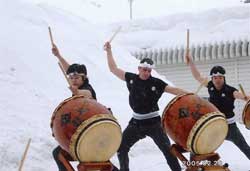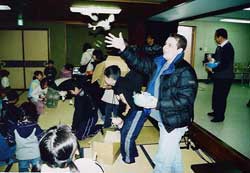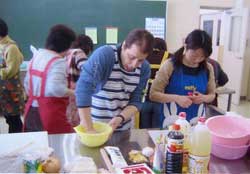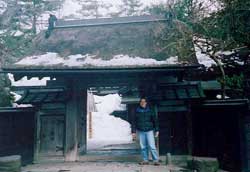June 1st, 2005
By Chris Abeyta
Nippon Kan Student
Nippon-Kan is more than a martial arts dojo. When I began my practice, I never would have guessed I would learn so much off the mat. As a participant in Nippon-Kan’s cross cultural exchange program, I spent three months in a Japanese village called Higashi Naruse. For the first time in my life I traveled alone. Dr. Marc Volkel, an alum of this program, gave me some good language material to study, and some valuable advice on do’s, don’ts and generally what to expect. The day before I left, Homma Sensei gave me detailed instructions about where to catch which trains and at what times “…and after that, just good luck!” Indeed as luck would have it, while standing in line to check in at the airport, I ran into an old friend of Homma Sensei’s who was in Denver for Keiko Hajime, which was held just a couple days before. He was taking the same flight! He was a tremendous help to me in finding my way through Narita Airport and getting my train tickets out to the village.
When I arrived in Jumonji, the closest train station to Higashi Naruse, I was met there by my new boss, and an old friend of Homma Sensei’s, Hideki Sugawara. Hideki San speaks pretty good English, and welcomed me very warmly. He took me to a ryokan to spend the first several days of my stay in the village. He introduced me to the Gotou family, who were to become my best friends over the course of the next three months. In fact, so nice were they that I did not at first know I was staying at an Inn. I only found that out about four days later. They put me up in a room that was like something out of a samurai movie; tatami mats, shoji doors, and beautiful Japanese artwork everywhere I looked. I was much honored to be made so comfortable. That afternoon and the next day, Kazuki, Gotoya San’s son, kept me company. He spoke very little English, but we are able to communicate. He brought out his computer, and we used an Internet translation program.
I had been warned that the snowfall would be impressive. The day I got in, there was only about 2 feet of snow on the ground. The weather turned bad on the second day. We had planned to go to a local Onsen or hot spring, but driving would be dangerous. Instead we walked around the village a little. He took me to The Yakuba, and to Higashi Naruse Junior High School. They have amazing ways of dealing with the snow. The road to the school is rather steep and winding, which makes shoveling or plowing very difficult. To get around this problem, they have an ingenious solution. Along the sides and down the middle of the road they have water sprinklers. When the snow starts to fall, they turn this on and the water runs down the road. The water is always moving, and as a result does not freeze. It also melts the snow as it falls. It runs downhill into the creek, running along side the main road, and out to the river. Snow from the front of buildings is also dumped into the creek, to prevent a massive buildup of shoveled snow. I was amazed.
When Tuesday came, I went to work. I was given a desk and a computer with Internet in the Education Department office at the Yakuba. They took me around the building and introduced me to everyone there. I met the Mayor, and all the different department heads. I also went to the Elementary and Junior High schools to meet the Principals. This was the first time I had gone to the Principal’s office as a guest, rather than an offender. For the rest of the week I went to the office at 8:00 and studied Japanese on-line. I also kept in touch with family and friends via e-mail. Hideki San told me I would be assisting the English teachers at The Junior High School. I would begin my new job on Monday.
On Thursday, I attended the Junior High school’s opening ceremonies for the last semester. I was asked to make a short speech to introduce myself. I spoke English and Matsue Sensei, the English teacher translated what I said. They took a picture of me giving my speech, and they put it in the school newspaper. Matsue Sensei told me basically how the classes would go. She would give me a daily briefing on the upcoming lessons, and how I could help her. As she progressed through the textbook, at each new lesson I would read through the material as a sort of model. This way the students were able to hear English as spoken by a native.
After ten days, I was moved to Iwaikawa, into a house lent to me by a local family. The Education office provided me with a couple of space heaters, a futon and some blankets. In anticipation of the move I went shopping and bought some foods I could easily prepare myself. When I first moved the boiler was broken so there was no hot water. Folks from the office would drop me off at Junesse ski area so I could take a shower and soak in the onsen. After a few days, they got the boiler fixed so I was able to shower at home. As I was living alone I was expected to keep the entry clear of snow. I would get home after work and before even putting my things away, I would start shoveling. Every home had either a creek running by or a grate in the street out front with water flowing underneath. This way the snow could be carried out to the river without having huge piles for the big plows to move. I would lift the grate and shovel all the snow from the front of my house down into the pit. I joked that I now have a black belt in snow removal. Almost every night would see more snowfall. In the mornings someone (I never found out who) would come and snow-blow the front of my house. I was never able to get up in time to see who it was. They must have been out there before 5 am, because I got up once to leave at that time, and it was already done. I will never forget that lesson: Help your neighbors, even if there is no recognition. It’s just a nice thing to do.
Hideki San asked me if I wanted to join the Local Taiko Drumming club. Another former participant told me that if I got the chance I should try it out. He said the people were about my age and very nice, so I agreed. The group met to practice every Monday, and Thursday. The next practice time, I would join them. I had never before done anything remotely musical, so I sort of joined in whatever they were doing and tried to keep as close to the rhythm as possible so as not to distract them. They were all very tolerant. I found out later that this was serious stuff. They are the village’s Taiko players who perform on stage at village festivals and gatherings. They practice to play, not to play. Tsutomu San, the group leader started teaching me what I thought was just sort of fundamental learning phrases. I was wrong. I found out later that he was teaching me a piece that we would play as a group in the upcoming snow festival. Over the course of the next month, a different person taught me every week. They would have me practice a few phrases, then add that to what I had already learned previously. As I mentioned earlier, I have no musical experience, and I cannot read music, so I had to learn by memorization.
Taiko drumming is not only about getting the notes correct, it is also about beauty. Each note is played by a certain hand, with correct form, so that in a performance all the players are synchronized and the result is quite lovely to watch. I had just enough time to learn the song. By the time the Yukimatsuri came along, I was not a total embarrassment. We played Kurikoma Oroshi, to open the festival. I made a few mistakes, but the crowd was very nice. The Master of Ceremonies announced me and told the audience that I had only been practicing for one month. They were very generous with their applause. Many of them came up to me afterward and offered compliments and congratulations.
The uniforms we wore were traditional; very beautiful, but also very thin and sleeveless. Our stage was outside, and made of snow. We very quickly set up the drums, got into position and began playing. After finishing, we all got to enjoy the festival. At the conclusion of the festival, I helped tear down the tents and return them to the Yakuba. I also caught a slight cold.
By this time my days and weeks got into a routine. Either Hirokatsu San or Kaori San would go and pick me up in the morning and take me to the Junior High School. I would attend the English classes, and have a school lunch with the students. In the afternoon, I would either go back to the Yakuba, or stay for any further classes scheduled for that day. At the Yakuba I would study Japanese and write e-mails. On Taiko nights, I would go home and do a little solo practice before being picked up by Tsutomu San to attend regular practice. On non-Taiko night I would frequently go to Gotou Ryokan for dinner and conversation.
Some of the best Japanese practice I had was on these nights. Neither Shokou San nor Gotou San spoke any English at all, so I would take my homemade flash cards to aid in our communication. Shokou San would look at my flash cards and study the English. Sometimes she would come across a flash card look at me sideways and say, “I don’t understand you’re Japanese.” She would try and understand what I was trying to say and help me with the correct words. I think we both learned a great deal. We also used the Internet to translate some of our more complex conversations that were beyond my capabilities in Japanese. I grew very fond of those folks. At the end of the evening, Shokou San would drive me home and give me some food for later.
Kaori San the wife and daughter of the two local Buddhist Priests lives in the House right behind mine that was connected to the Temple. She speaks excellent English, and was a great friend to me. In February, she and her family took me to Oga City. We stayed at a very nice Bed and Breakfast right on the shore of the Sea of Japan. For dinner we ate dishes that are famous in Oga. The main soup was seafood and vegetables cooked with hot rocks. They put the fish, crab, clams, etc. in a large wooden tub. On top of this they add a bunch of pre-heated rocks that very quickly boil the water and cook the dish. In addition to this, they had trays prepared with three to four layers of cuisine. The trays were laden with assorted sashimi, crab, sea cucumber and some things I was unable to identify. I had never before had such a large amount of food spread out in front of me.
The next day, we went to the Namahage museum in Oga. I saw Namahage Taiko play there and also watched a reenactment of the Namahage New Years Eve visit. Though I couldn’t understand what was being said, I enjoyed the experience. The reenactment took place in an antique house, with the audience seated to one side. After the performance Namahage San walked around to scare the children in attendance. After that we went to Gao Aquarium. Gao is a beautiful modern building right on the rocky shore of the Sea of Japan. The huge glass wall looks out on the shore right above where the waves break on the rocks. Before I went, this is what I pictured an Asian shoreline to look like; ragged black rock jutting out of the pristine blue water with foam lapping at the base. Gorgeous. All the fish tanks had both Japanese and English explanations so there was no problem understanding there.
The next week, Shokou San and Gotou San took me sightseeing. We drove out to Morioka and visited Tezukuri Mura. We walked around and watched the various artisans make their wares and even did one ourselves. I made a Sembei cracker, which I have kept wrapped as a souvenir. We watched metal workers casting teapots and weavers making bamboo baskets. There was also an antique house to tour there. It was a really great window into how farmers lived in earlier eras. Every point of interest had a speaker with a button to push for a recorded explanation. As in Oga, there were both English and Japanese options.
From Morioka, we went to Kakunodate. Kakunodate is famous for “Shi Kyoto” which is a street preserved from medieval times. We visited the local samurai headquarters, the lord’s house, and beautiful gardens. In one of the gift shops, Shokou San pointed out a lovely picture of the street resplendent with huge cherry trees in full bloom. At this point a joke was born. Thereafter, when I would be shown a picture of flowers or tree blossoms Shokou San would say “May is beautiful.” This was funny because I would be leaving in April.
On February 20th, in Iwaikawa we had a community festival. Along with traditional dancing and singing, foods prepared by the Junior High School students, and plenty of sake, the children’s group played Taiko. I gave a short speech introducing myself and thanking Homma Sensei and the folks at the Education department for the opportunity to travel to and stay in Higashi Naruse. We played Kurikoma Oroshi, to a very nice crowd in the Community Center. After all the scheduled events, it was time to drink sake. More food was brought in, along with a generous supply of various kinds of alcohol and we all sat and talked. I talked to and drank with the Mayor and even did karaoke for the first time. I sang Yesterday by the Beatles and was gustily cheered along. Everyone was very tolerant with my broken Japanese. There was also an eighty-five year old man who sang an old samurai song and danced along with some cool sword-work.
A few days before I came home I had my last Taiko performance. In the Manga-Kan, there was an all Akita-Ken Taiko festival. All the various groups from different towns came and played. It was an all day event. Among the more famous groups was Namahage Taiko. Each group had a different style of traditional dress, from Kimonos to demon masks, to pants and no shirts. In this venue, I played two songs. I played Kurikoma Oroshi with the children again and also Sakae with the adult group. This was the first time I played in practice or on stage, without making any mistakes. It’s a good thing too because I was in the front row of drummers and any mistake would be very visible. I had a few tense moments as our turn began, because with all the music being played that day, I had a hard time keeping our tune in my head. Luckily, it only took a small reminder to get me back on track. I still sometimes find myself tapping out this tune at various quiet moments.
The week before I left the school was on spring break. Not having to go to the school to help teach, I spent my days at the Education Department. In the afternoons, a group of kids would come to the Yakuba for a craft-making class. I joined in and made them as well. We made pressed flower post cards, string climbing puppets and a Tea Ceremony. There was also a local storyteller who came but I did not understand one word. Arihara Sensei asked me afterward if I could follow what was being said. I said I couldn’t, and he said not to worry, He didn’t understand a lot of it either. The village language is different entirely from standard Japanese. There were times, when I got to feel pretty confident I could make myself understood, that I would talk to an older person who grew up in the village, and I was back to square one. One time, I was talking to an older person, and learned the word ‘daibuki’ which means blizzard. I later used this word and got a bunch of raised eyebrows. “Where did you learn that,” they asked me. They understood, but to hear an American use the word clearly surprised them.
On my last morning in the village, many of the friends I had made over the course of my stay went to see me off at the train station. I was laden with food and drink and wished well. I spent the whole day in transit, and was very grateful for the food. Toward the end of the train ride to Narita, I asked the man sitting next to me in Japanese if I should ride to the first or second terminal stop. He shocked me by answering in English that he did not know. It was then that I stopped thinking about what I wanted to say, and then translating it into Japanese. That was the moment it hit me: time to go home. I made friends in Higashi Naruse that I will never forget. I was treated as an honored guest and given every courtesy the whole time. I will go to Higashi Naruse again on vacation. It’s just too cool a place not to visit.
- Playing taiko drums in the Snow Festival.
- Throwing mochi (rice cakes) to the children after playing the taiko drums.
- Cooking gyoza with the wives in Higashi Naruse.
- The cold of Japanese winters.





